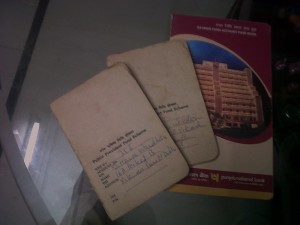Harsh Wardhan Jog commented on the post, About Pass Book 10 years, 10 months ago
What does entries in pass book show?
Besides entries of deposits & withdrawls made , pass book also shows entries relating to charges levied by the bank & interest allowed on the deposits made.
What about […]
Harsh Wardhan Jog wrote a new post, About Pass Book 10 years, 10 months ago
What is a Pass Book?
A Pass Book can be defined as a paper booklet issued by a banker to a customer recording therein entries of deposits and withdrawals made. Alternatively it can also be said to be a copy of […]
Harsh Wardhan Jog commented on the post, Have you replaced Smart Credit Card from Bank with PIN and CHIP 10 years, 10 months ago
In June 2013, RBI had extended the the date of changing to chip based card till Nov 2013. Most of the private banks have already done so but not PSBs who have been slower.
It is not generally happening as […]Harsh Wardhan Jog wrote a new post, Know all about ATM 10 years, 10 months ago
What is an ATM?
An automated teller machine or ATM may be described as a machine that allows customers of banks to access their bank accounts without help of a cashier or a teller 24*7*365. Customers can withdraw cash, transfer funds to other accounts, get to know the balance available and get a statement of account for last couple of transactions.
ATM can identify the customer when he inserts plastic card with a magnetic stripe or card with a chip containing useful data. Now a days biometric ATM s are also available which can read the thumb or finger impression.
All the transactions need further authentication by customer by way of putting in the personal identification number PIN. Many further innovations in the functioning of ATM s are happening including operation by mobile phone.
When was first ATM operational?
It all began in 1961 when a machine called Bankograph was installed by CitiBank of New York for accepting automated envelope deposit containing coins cash or cheques. It did not dispense cash and hardly lasted six months as customers did not show any interest.
In 1969, Chemical Bank installed first ATM in the US in New York. This machine dispensed fixed amounts of cash when customer inserted his coded card. Here magnetic coding was introduced for the first time. This was designed by Donald Wetzel & was called Docuteller.
In 1972 Lloyds Bank installed IBM 2984 Cash Issuing Terminal which was perhaps the first modern ATM.
When was first ATM installed in India?
In India ATM made its first appearance in 1987 when HSBC introduced the concept. Presently ATM s are spread far and wide all over the globe. The most northerly ATM is in Norway and most southerly in New Zealand’s Ross Dependency in Antarctica. Highest installed ATM is by Axis Bank at Nathu La at 13200 ft. though Chinese media claims to have highest installed ATM at Nagchu, Tibet. And the lowest one is at 421 meters below sea level at Ein Bokek, Israel.
How ATMs are connected in India?
In India practically all the ATMs are interconnected with National Financial Switch (NFS) designed & implemented by Institute of Development & Research in Banking Technology, Hyderabad.
As of Sept 13 this network connects approx 1.40 lacs ATM s of 74 member banks, 99 sub-member banks, 42 RRB s & 1 White Label provider. White Label ATMs known as WLAs are provided by non banking companies approved by RBI.
//
Caution ! Customers should not leave the ATM without collecting their cash as per the latest RBI Guidelines. You may loose your money due to technical delay in dispensing the cash. Machine may take more time to dispense cash as against normal time of 15-20 seconds.


Dear Harsh Wardhan ji, It is requested that expand the article by adding :
1. Legal Consequences of wrongful entries.
2. Entries explained especially bank charges and wrong debits resulting into dishonor of cheques.
3. Articles with more than 500 words are preferred by search engines.
Regards
Webmaster